LAMP-2 Is Involved in Surface Expression of RANKL of Osteoblasts In Vitro
Abstract
1. Introduction
2. Materials and Methods
2.1. Mice
2.2. Microscopy
2.3. Volume Density Determination of Intracellular Vesicles
2.4. Micro Computed Tomography (µCT)
2.5. Bone Marrow Cell Isolation
2.6. Osteoclast Generation Using M-CSF and RANKL
2.7. Bone Resorption
2.8. Isolation of Osteoblast-Like Cells
2.9. Co-Culture
2.10. Tartrate Resistant Acid Phosphatase (TRAcP) Staining
2.11. Quantitative RT-PCR
2.12. Immunolocalization of LAMP-2 and RANKL
2.13. FACS Analysis of RANKL
2.14. Statistics
3. Results
3.1. LAMP-2 Is Present in Osteoclasts and Osteoblasts
3.2. Osteoclasts Are Present in LAMP-2-/y Mice
3.3. Bone Volume Is Not Affected in LAMP-2-/y
3.4. Osteoclasts Are Readily Formed from LAMP-2-/y Bone Marrow Precursors
3.5. Vacuoles Are Abundantly Present in LAMP-2-/y Osteoblasts
3.6. Osteoblastic LAMP-2 Is Essential for Osteoclastogenesis
3.7. Expression of Osteoclast-Related Genes Is Affected in the Co-Cultures
3.8. Expression of Osteoclastogenesis-Related Genes Is Affected in the Co-Cultures
3.9. Lower RANKL Surface Expression of LAMP-2-/y Osteoblasts
4. Discussion
Author Contributions
Funding
Acknowledgments
Conflicts of Interest
References
- Appelqvist, H.; Wäster, P.; Kågedal, K.; OLlinger, K. The lysosome: From waste bag to potential therapeutic target. J. Mol. Cell Biol. 2013, 5214–5226. [Google Scholar] [CrossRef] [PubMed]
- Luzio, J.P.; Pryor, P.R.; Bright, N.A. Lysosomes: Fusion and function. Nat. Rev. Mol. Cell Biol. 2007, 8, 622–632. [Google Scholar] [CrossRef]
- Eskelinen, E.L. Roles of LAMP-1 and LAMP-2 in lysosome biogenesis and autophagy. Mol. Asp. Med. 2006, 27, 495–502. [Google Scholar] [CrossRef] [PubMed]
- Andrejewski, N.; Punnonen, E.L.; Guhde, G.; Tanaka, Y.; Lüllmann-Rauch, R.; Hartmann, D.; von Figura, K.; Saftig, P. Normal lysosomal morphology and function in LAMP-1-deficient mice. J. Biol. Chem. 1999, 274, 12692–12701. [Google Scholar] [CrossRef]
- Hunziker, W.; Simmen, T.; Höning, S. Trafficking of lysosomal membrane proteins in polarized kidney cells. Nephrologie 1996, 17, 347–350. [Google Scholar] [PubMed]
- Saftig, P.; Schröder, B.; Blanz, J. Lysosomal membrane proteins: Life between acid and neutral conditions. Biochem. Soc. Trans. 2010, 38, 1420–1423. [Google Scholar] [CrossRef] [PubMed]
- Zhou, D.; Li, P.; Lin, Y.; Lott, J.M.; Hislop, A.D.; Canaday, D.H.; Brutkiewicz, R.R.; Blum, J.S. Lamp-2a facilitates MHC class II presentation of cytoplasmic antigens. Immunity 2005, 22, 571–581. [Google Scholar] [CrossRef]
- Crotzer, V.L.; Glosson, N.; Zhou, D.; Nishino, I.; Blum, J.S. LAMP-2-deficient human B cells exhibit altered MHC class II presentation of exogenous antigens. Immunology 2010, 131, 318–330. [Google Scholar] [CrossRef]
- Dell’angelica, E.C. Lysosome-related organelles. FASEB J. 2000, 14, 1265–1278. [Google Scholar] [CrossRef]
- Luzio, J.P.; Poupon, V.; Lindsay, M.R.; Mullock, B.M.; Piper, R.C.; Pryor, P.R. Membrane dynamics and the biogenesis of lysosomes. Mol. Membr. Biol. 2003, 20, 141–154. [Google Scholar] [CrossRef]
- Janvier, K.; Bonifacino, J.S. Role of the endocytic machinery in the sorting of lysosome-associated membrane proteins. Mol. Biol. Cell 2005, 16, 4231–4242. [Google Scholar] [CrossRef] [PubMed]
- Eskelinen, E.L.; Schmidt, C.K.; Neu, S.; Willenborg, M.; Fuertes, G.; Salvador, N.; Tanaka, Y.; Lüllmann-Rauch, R.; Hartmann, D.; Heeren, J.; et al. Disturbed cholesterol traffic but normal proteolytic function in LAMP-1/LAMP-2 double-deficient fibroblasts. Mol. Biol. Cell 2004, 15, 3132–3145. [Google Scholar] [CrossRef] [PubMed]
- Saftig, P.; von Figura, K.; Tanaka, Y.; Lüllmann-Rauch, R. Disease model: LAMP-2 enlightens Danon disease. Trends Mol. Med. 2001, 7, 37–39. [Google Scholar] [CrossRef]
- Tanaka, Y.; Guhde, G.; Suter, A.; Eskelinen, E.L.; Hartmann, D.; Lüllmann-Rauch, R.; Janssen, P.M.L.; Blanz, J.; von Figura, K.; Saftig, P. Accumulation of autophagic vacuoles and cardiomyopathy LAMP-2-deficient mice. Nature 2000, 406, 902–906. [Google Scholar] [CrossRef]
- Beertsen, W.; Willenborg, M.; Everts, V.; Zirogianni, A.; Podschun, R.; Schröder, B.; Eskelinen, E.-L.; Saftig, P. Impaired Phagosomal Maturation in Neutrophils Leads to Periodontitis in Lysosomal-Associated Membrane Protein-2 Knockout Mice. J. Immunol. 2008, 180, 475–482. [Google Scholar] [CrossRef]
- Matsuo, K.; Irie, N. Osteoclast-osteoblast communication. Arch. Biochem. Biophys. 2008, 473, 201–209. [Google Scholar] [CrossRef]
- Nakashima, T.; Hayashi, M.; Fukunaga, T.; Kurata, K.; Oh-Hora, M.; Feng, J.Q.; Bonewald, L.F.; Kodama, T.; Wutz, A.; Wagner, E.F.; et al. Evidence for osteocyte regulation of bone homeostasis through RANKL expression. Nat. Med. 2011, 17, 1231–1234. [Google Scholar] [CrossRef]
- Honma, M.; Ikebuchi, Y.; Kariya, Y.; Suzuki, H. Regulatory mechanisms of RANKL presentation to osteoclast precursors. Curr. Osteoporos. Rep. 2014, 12, 115–120. [Google Scholar] [CrossRef]
- Aoki, S.; Honma, M.; Kariya, Y.; Nakamichi, Y.; Ninomiya, T.; Takahashi, N.; Udagawa, N.; Suzuki, H. Function of OPG as a traffic regulator for RANKL is crucial for controlled osteoclastogenesis. J. Bone Miner. Res. 2010, 25, 1907–1921. [Google Scholar] [CrossRef]
- Honma, M.; Ikebuchi, Y.; Kariya, Y.; Hayashi, M.; Hayashi, N.; Aoki, S.; Suzuki, H. RANKL subcellular trafficking and regulatory mechanisms in osteocytes. J. Bone Miner. Res. 2013, 28, 1936–1949. [Google Scholar] [CrossRef]
- Everts, V.; Korper, W.; Jansen, D.C.; Steinfort, J.; Lammerse, I.; Heera, S.; Docherty, A.J.P.; Beertsen, W. Functional heterogeneity of osteoclasts: Matrix metalloproteinases participate in osteoclastic resorption of calvarial bone but not in resorption of long bone. FASEB J. 1999, 13, 1219–1230. [Google Scholar] [CrossRef] [PubMed]
- Jansen, I.D.C.; Mardones, P.; Lecanda, F.; Vries, T.J.; Recalde, S.; Hoeben, K.A.; Schoenmaker, T.; Ravesloot, J.-H.; Borren, M.M.G.J.; Eijden, T.M.; et al. Ae2a,b-Deficient mice exhibit osteopetrosis of long bones but not of calvaria. FASEB J. 2009, 23, 3470–3481. [Google Scholar] [CrossRef] [PubMed]
- Everts, V.; de Vries, T.J.; Helfrich, M.H. Osteoclast heterogeneity: Lessons from osteopetrosis and inflammatory conditions. Biochim. et Biophys. Acta Mol. Basis Dis. 2009, 1792, 757–765. [Google Scholar] [CrossRef] [PubMed]
- Everts, V.; Korper, W.; Hoeben, K.A.; Jansen, I.D.C.; Bromme, D.; Cleutjens, K.B.J.M.; Heeneman, S.; Peters, C.; Reinheckel, T.; Saftig, P.; et al. Osteoclastic bone degradation and the role of different cysteine proteinases and matrix metalloproteinases: Differences between calvaria and long bone. J. Bone Miner. Res. 2006, 21, 1399–1408. [Google Scholar] [CrossRef]
- Wan, Q.; Schoenmaker, T.; Jansen, I.D.C.; Bian, Z.; de Vries, T.J.; Everts, V. Osteoblasts of calvaria induce higher numbers of osteoclasts than osteoblasts from long bone. Bone 2016, 86, 10–21. [Google Scholar] [CrossRef]
- Weibel, E.R. Stereological Principles for Morphometry in Electron Microscopic Cytology. Int. Rev. Cytol. 1969, 26, 235–302. [Google Scholar] [CrossRef]
- Giesen, E.B.W.; Ding, M.; Dalstra, M.; van Eijden, T.M.G.J. Architectural measures of the cancellous bone of the mandibular condyle identified by principal components analysis. Calcif. Tissue Int. 2003, 73, 225–231. [Google Scholar] [CrossRef]
- de Vries, T.J.; Schoenmaker, T.; Beertsen, W.; van der Neut, R.; Everts, V. Effect of CD44 deficiency on in vitro and in vivo osteoclast formation. J. Cell. Biochem. 2005, 94, 954–966. [Google Scholar] [CrossRef]
- Bakker, A.D.; Klein-Nulend, J. Osteoblast isolation from murine calvaria and long bones. Methods Mol. Biol. 2012, 816, 19–29. [Google Scholar] [CrossRef]
- Beek, E.M.; Vries, T.J.; Mulder, L.; Schoenmaker, T.; Hoeben, K.A.; Matozaki, T.; Langenbach, G.E.J.; Kraal, G.; Everts, V.; Berg, T.K. Inhibitory regulation of osteoclast bone resorption by signal regulatory protein α. FASEB J. 2009, 23, 4081–4090. [Google Scholar] [CrossRef]
- Wada, T.; Nakashima, T.; Hiroshi, N.; Penninger, J.M. RANKL-RANK signaling in osteoclastogenesis and bone disease. Trends Mol. Med. 2006, 12, 17–25. [Google Scholar] [CrossRef] [PubMed]
- Lacey, D.L.; Timms, E.; Tan, H.L.; Kelley, M.J.; Dunstan, C.R.; Burgess, T.; Elliott, R.; Colombero, A.; Elliott, G.; Scully, S.; et al. Osteoprotegerin ligand is a cytokine that regulates osteoclast differentiation and activation. Cell 1998, 93, 165–176. [Google Scholar] [CrossRef]
- Endo, Y.; Furuta, A.; Nishino, I. Danon disease: A phenotypic expression of LAMP-2 deficiency. Acta Neuropathol. 2015, 129, 391–398. [Google Scholar] [CrossRef] [PubMed]
- Yu, X.; Huang, Y.; Collin-Osdoby, P.; Osdoby, P. Stromal cell-derived factor-1 (SDF-1) recruits osteoclast precursors by inducing chemotaxis, matrix metalloproteinase-9 (MMP-9) activity, and collagen transmigration. J. Bone Miner. Res. Off. J. Am. Soc. Bone Miner. Res. 2003, 18, 1404–1418. [Google Scholar] [CrossRef] [PubMed]
- Takayanagi, H.; Kim, S.; Koga, T.; Nishina, H.; Isshiki, M.; Yoshida, H.; Saiura, A.; Isobe, M.; Yokochi, T.; Inoue, J.I.; et al. Induction and activation of the transcription factor NFATc1 (NFAT2) integrate RANKL signaling in terminal differentiation of osteoclasts. Dev. Cell 2002, 3, 889–901. [Google Scholar] [CrossRef]
- Yagi, M.; Ninomiya, K.; Fujita, N.; Suzuki, T.; Iwasaki, R.; Morita, K.; Hosogane, N.; Matsuo, K.; Toyama, Y.; Suda, T.; et al. Induction of DC-STAMP by alternative activation and downstream signaling mechanisms. J. Bone Miner. Res. 2007, 22, 992–1001. [Google Scholar] [CrossRef]
- Hubert, V.; Peschel, A.; Langer, B.; Gröger, M.; Rees, A.; Kain, R. LAMP-2 is required for incorporating syntaxin-17 into autophagosomes and for their fusion with lysosomes. Biol. Open 2016, 5, 1516–1529. [Google Scholar] [CrossRef]
- Kariya, Y.; Honma, M.; Aoki, S.; Chiba, A.; Suzuki, H. Vps33a mediates RANKL storage in secretory lysosomes in osteoblastic cells. J. Bone Miner. Res. 2009, 24, 1741–1752. [Google Scholar] [CrossRef]
- Ostrowski, M.C. A new role for OPG: Putting RANKL in its place. J. Bone Miner. Res. 2010, 25, 1905–1906. [Google Scholar] [CrossRef]
- Dar, A.; Kollet, O.; Lapidot, T. Mutual, reciprocal SDF-1/CXCR4 interactions between hematopoietic and bone marrow stromal cells regulate human stem cell migration and development in NOD/SCID chimeric mice. Exp. Hematol. 2006, 34, 967–975. [Google Scholar] [CrossRef]
- Graves, D.T.; Alshabab, A.; Albiero, M.L.; Mattos, M.; Corrêa, J.D.; Chen, S.; Yang, Y. Osteocytes play an important role in experimental periodontitis in healthy and diabetic mice through expression of RANKL. J. Clin. Periodontol. 2018, 45, 285–292. [Google Scholar] [CrossRef]
- Ikebuchi, Y.; Aoki, S.; Honma, M.; Hayashi, M.; Sugamori, Y.; Khan, M.; Kariya, Y.; Kato, G.; Tabata, Y.; Penninger, J.M.; et al. Coupling of bone resorption and formation by RANKL reverse signalling. Nature 2018, 561, 195–200. [Google Scholar] [CrossRef] [PubMed]
- Metzger, C.E.; Narayanan, S.A. The Role of Osteocytes in Inflammatory Bone Loss. Front. Endocrinol. 2019, 10, 285. [Google Scholar] [CrossRef] [PubMed]
- Tilkeridis, K.; Kiziridis, G.; Ververidis, A.; Papoutselis, M.; Kotsianidis, I.; Kitsikidou, G.; Tousiaki, N.E.; Drosos, G.; Kapetanou, A.; Rechova, K.V.; et al. Immunoporosis: A New Role for Invariant Natural Killer T (NKT) Cells Through Overexpression of Nuclear Factor-κB Ligand (RANKL). Med Sci. Monit. Int. Med J. Exp. Clin. Res. 2019, 25, 2151–2158. [Google Scholar] [CrossRef] [PubMed]
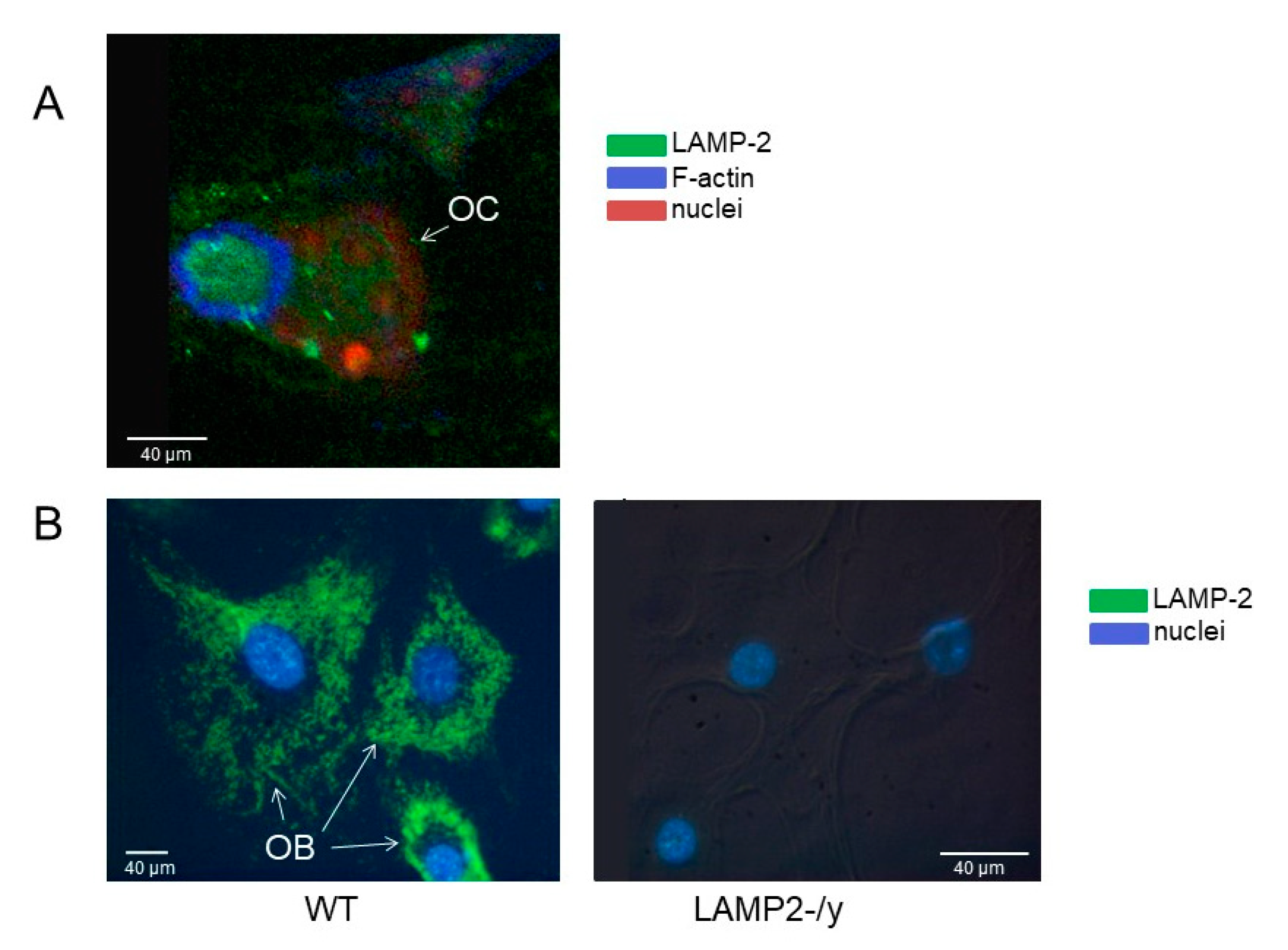
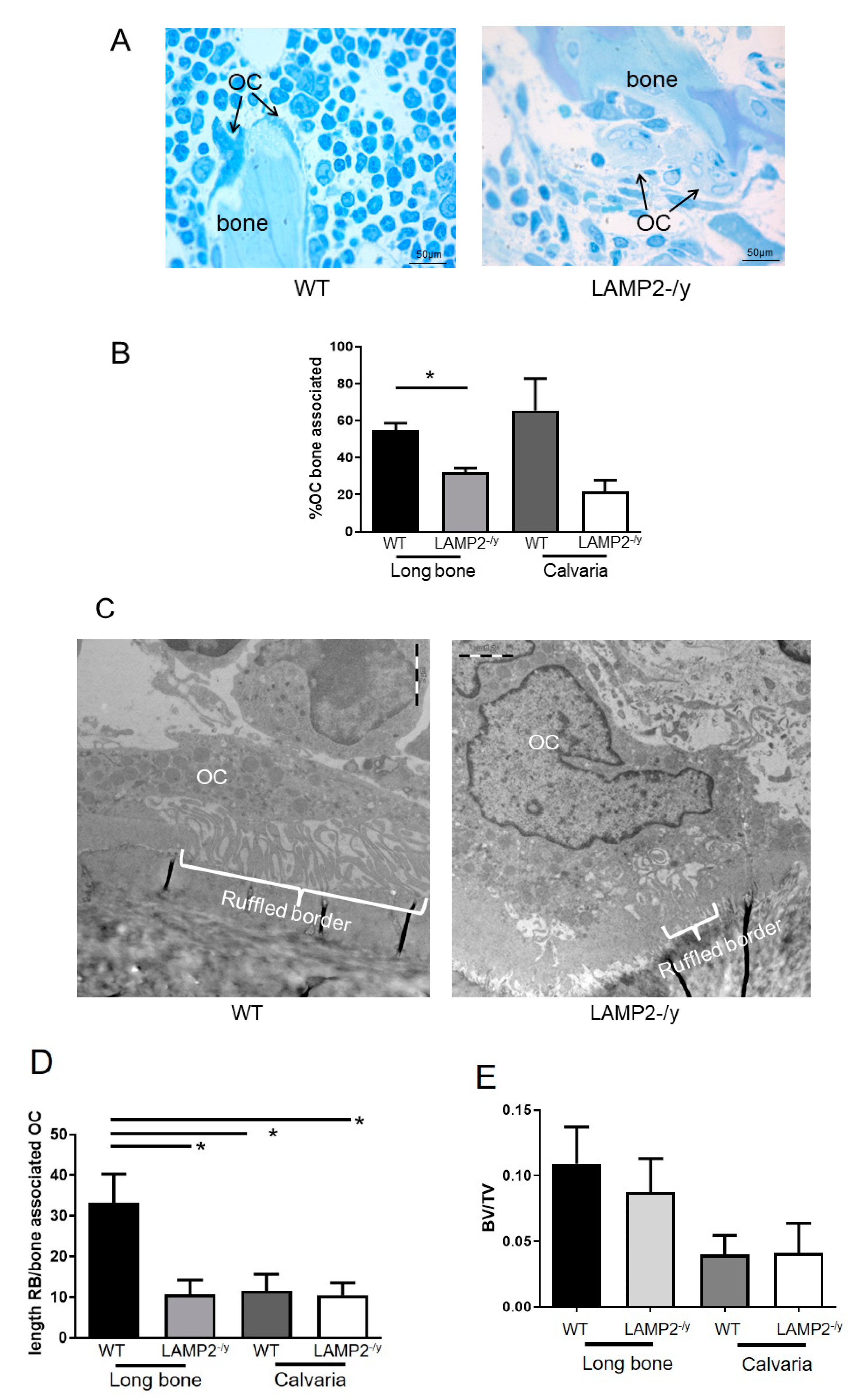
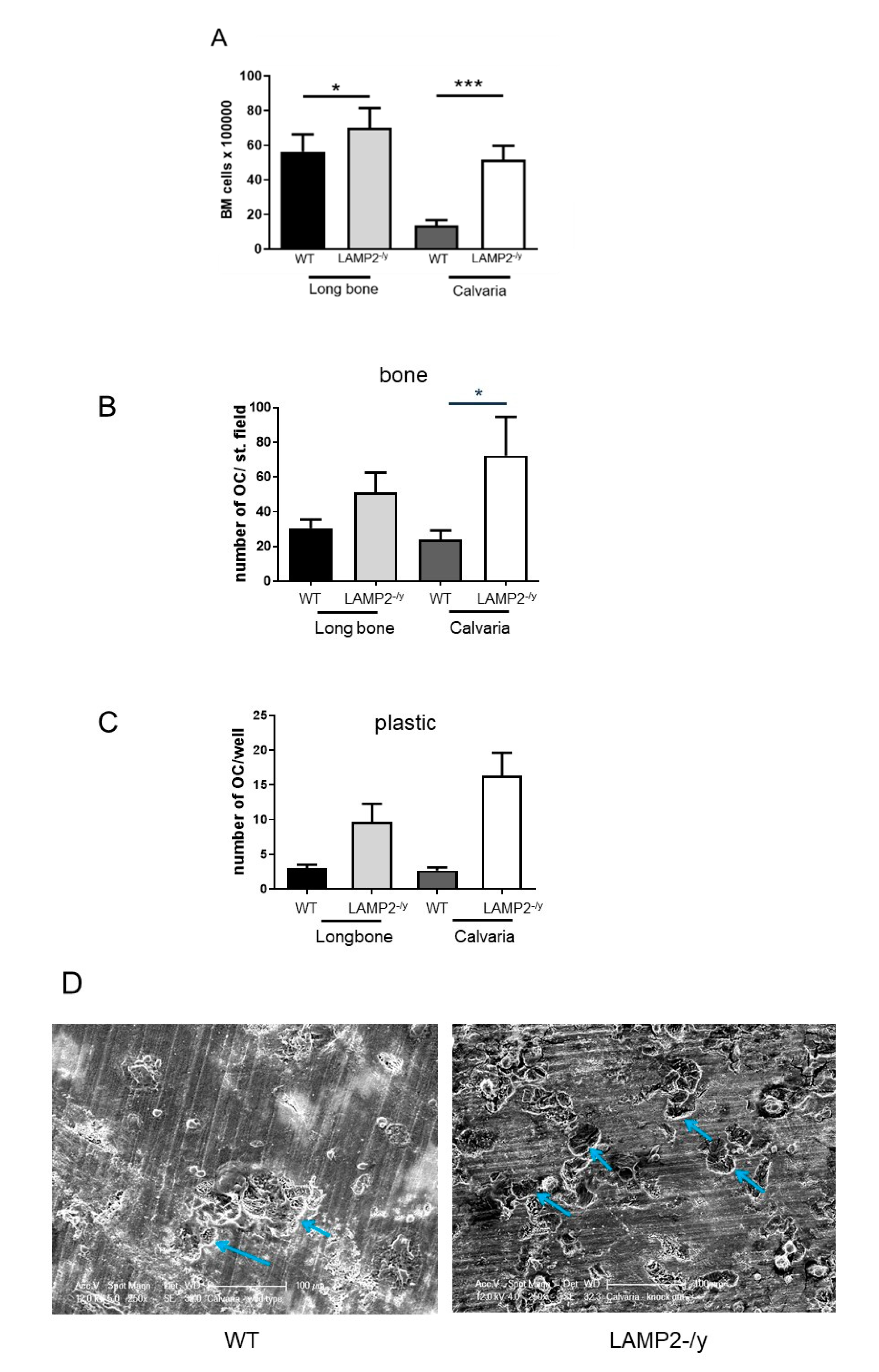
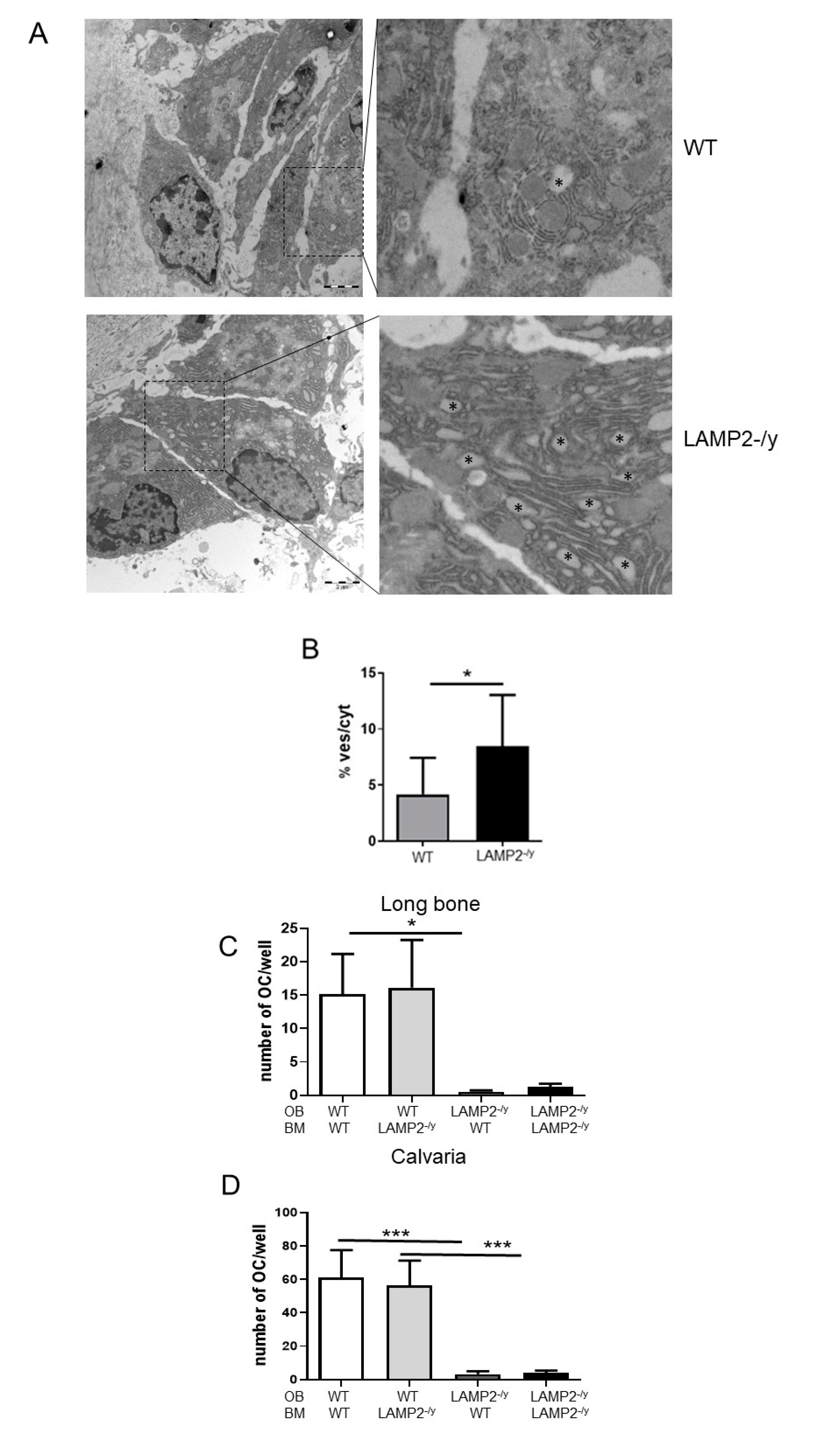
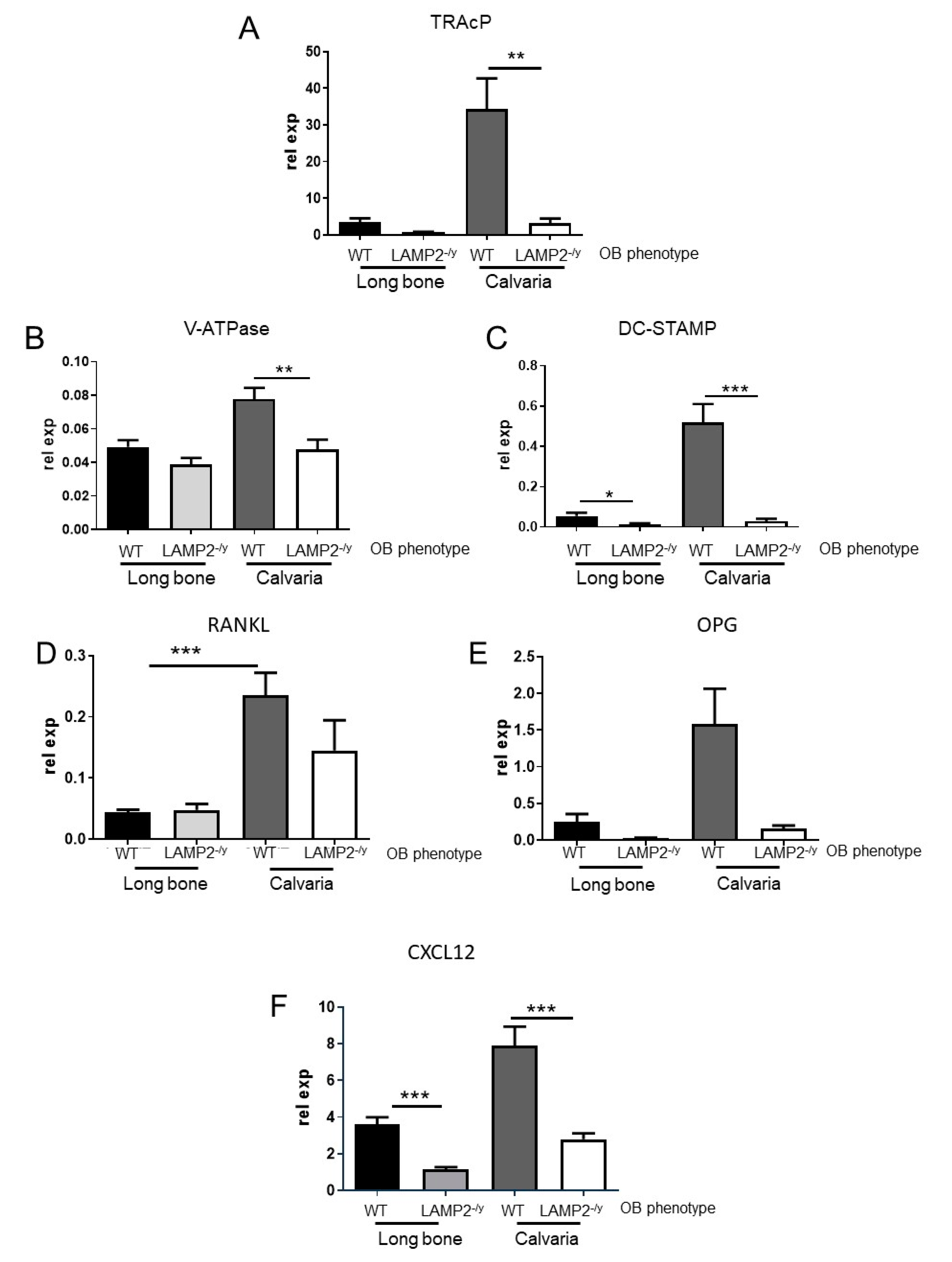
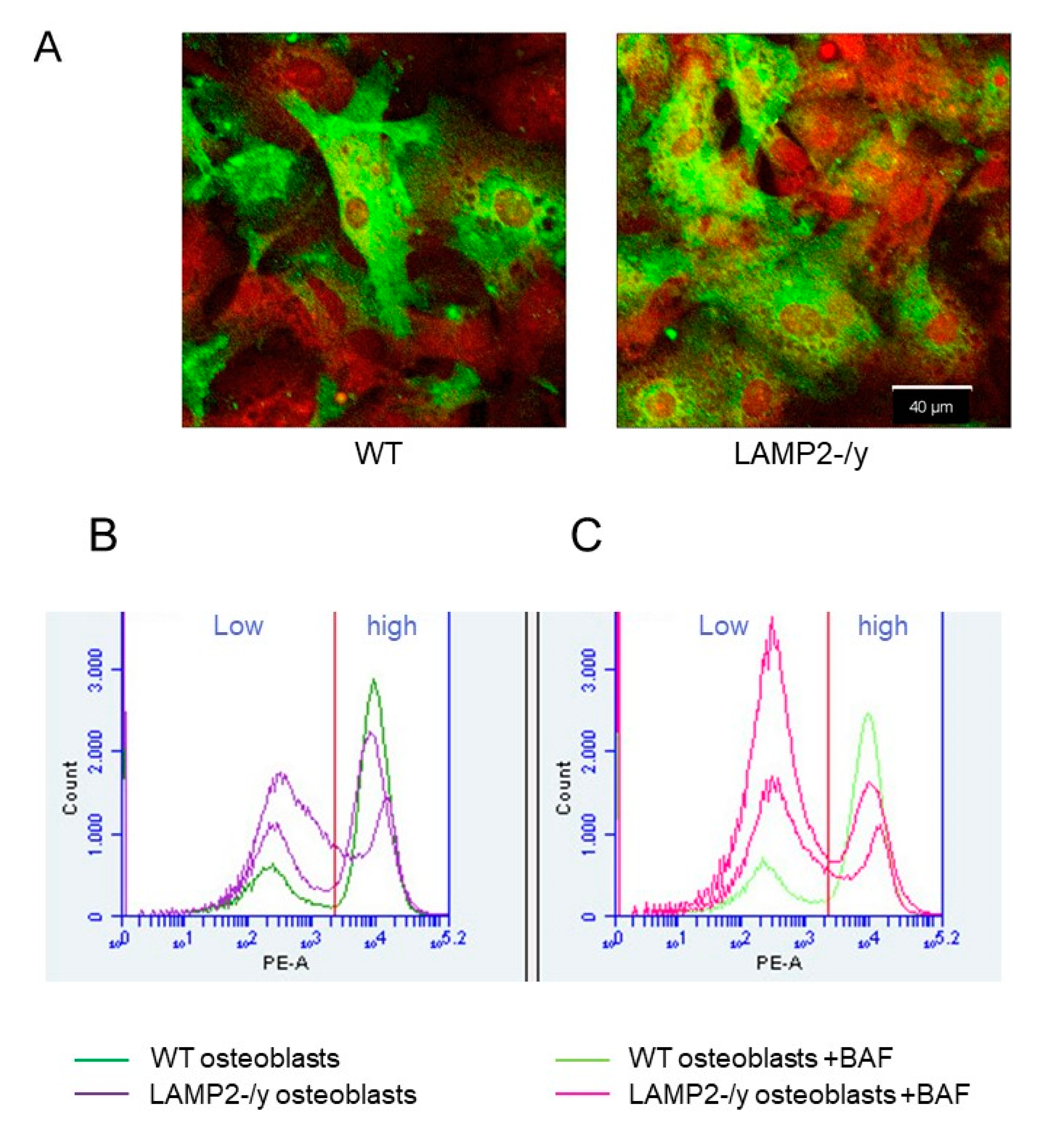
| Primer | Sequence 5′–3′ |
|---|---|
| HPRT | Fw: CCTAAgATgAgCgCAAgTTgAA Rv:CCACAggACTAgAACACCTgCTAA |
| RANKL | Fw: CTgAggCCCAgCCATTTg RV: ggAACCCgATgggATgCT |
| DC-STAMP | Fw: TgTATCggCTCATCTCCTCCAT Rv: gACTCCTTgggTTCCTTgCTT |
| v-ATPase(d2) | Fw: TggAACTAgCTCCTAACCACCT Rv: AgTTgTAAgCAgACCCTgTtgg |
| OPG | Fw: TCCggCgTggTgCAA Rv: ATACAgggTgCTTTCgATgAAgTC |
| CXCL12 | FW: TgTgCATTgACCCgAAATTA RV: TCTCACATCTTgAgCCTCTTgT |
| TRAcP | FW: gACAAgAggTTCCAggAgACC RV: gggCTggggAAgTTCCAg |
| Osteoblasts | % Low-Labeled Cells (L) | % High-Labeled Cells (R) |
|---|---|---|
| WT | 42 ± 2 | 58 ± 17 * |
| LAMP-2-/y | 77 ± 6 * | 23 ± 6 |
© 2020 by the authors. Licensee MDPI, Basel, Switzerland. This article is an open access article distributed under the terms and conditions of the Creative Commons Attribution (CC BY) license (http://creativecommons.org/licenses/by/4.0/).
Share and Cite
Jansen, I.D.C.; Tigchelaar-Gutter, W.; Hogervorst, J.M.A.; de Vries, T.J.; Saftig, P.; Everts, V. LAMP-2 Is Involved in Surface Expression of RANKL of Osteoblasts In Vitro. Int. J. Mol. Sci. 2020, 21, 6110. https://doi.org/10.3390/ijms21176110
Jansen IDC, Tigchelaar-Gutter W, Hogervorst JMA, de Vries TJ, Saftig P, Everts V. LAMP-2 Is Involved in Surface Expression of RANKL of Osteoblasts In Vitro. International Journal of Molecular Sciences. 2020; 21(17):6110. https://doi.org/10.3390/ijms21176110
Chicago/Turabian StyleJansen, Ineke D.C., Wikky Tigchelaar-Gutter, Jolanda M. A. Hogervorst, Teun J. de Vries, Paul Saftig, and Vincent Everts. 2020. "LAMP-2 Is Involved in Surface Expression of RANKL of Osteoblasts In Vitro" International Journal of Molecular Sciences 21, no. 17: 6110. https://doi.org/10.3390/ijms21176110
APA StyleJansen, I. D. C., Tigchelaar-Gutter, W., Hogervorst, J. M. A., de Vries, T. J., Saftig, P., & Everts, V. (2020). LAMP-2 Is Involved in Surface Expression of RANKL of Osteoblasts In Vitro. International Journal of Molecular Sciences, 21(17), 6110. https://doi.org/10.3390/ijms21176110






